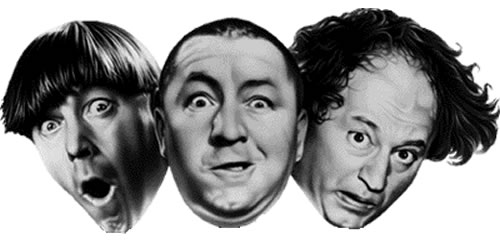
HOW THEY STARTED
There are so many different stories about the Stooges' origin that it's hard to know which is correct. Probably none of them. Anyway, here's one that sounds good: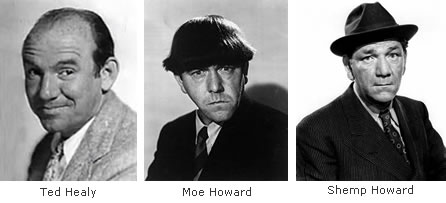
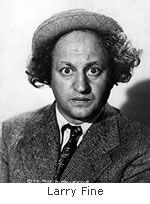 Moe, in turn, got his brother Shemp out of the audience, and the three of them did an impromptu routine that had the audience in stitches. Moe and Shemp loved the stage, so they changed their name from Horwitz to Howard and hit the road with their friend as "Ted Healy and the Gang" (or "Ted Healy and His Stooges," depending on who tells the story.)
Moe, in turn, got his brother Shemp out of the audience, and the three of them did an impromptu routine that had the audience in stitches. Moe and Shemp loved the stage, so they changed their name from Horwitz to Howard and hit the road with their friend as "Ted Healy and the Gang" (or "Ted Healy and His Stooges," depending on who tells the story.)In 1925, the trio was on the lookout for another member and spotted Larry Fine (real name: Louis Feinberg) playing violin with an act called the "Haney Sisters and Fine." Why they thought he'd be a good Stooge isn't clear, since he's never done comedy before. But he joined as the third Stooge, anyway.
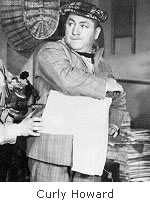 They traveled the vaudeville circuit for years under a variety of names, including Ted Healy and His Racketeers ... His Southern Gentlemen ... His Stooges, etc. Then they wound up in a Broadway revue in 1929, which led to a movie contract.
They traveled the vaudeville circuit for years under a variety of names, including Ted Healy and His Racketeers ... His Southern Gentlemen ... His Stooges, etc. Then they wound up in a Broadway revue in 1929, which led to a movie contract.In 1931, Shemp quit and was replaced by his younger brother, Jerry. Jerry had a full head of hair and a handsome mustache - but Healy insisted he shave them both off ... hence the name "Curly."
Three years later, after a bitter dispute, the boys broke up with Healy. They quickly got a Columbia film contract on their own, and the Three Stooges were born.
Here's the very first Three Stooges short film, "Woman Haters" (1934)
[YouTube Link Part I | Part II], about 10 min. each.
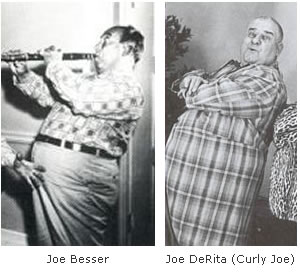
INSIDE FACTS
Two-Fingered Poker
One day backstage in the '30s, Larry, Shemp, and Moe were playing cards. Shemp accused Larry of cheating. After a heated argument, Shemp reached over and stuck his fingers in Larry's eyes. Moe, watching, thought it was hilarious ... and that's how the famous poke-in-the-eyes routine was born.Profitable Experience
By the mid-'50s, the average budget for a Three Stooges' episode - including the stars' salaries - was about $16,000. Depending on the time slot, Columbia Pictures can now earn more than that with one showing of the same film ... in one city.So What If He's Dead?
By the mid-'50s the demand for short films had petered out. So, in 1957, Columbia unceremoniously announced they weren't renewing the Stooges' contracts. Moe and Larry were devastated. After 23 years, what else would they do? Moe was rich from real estate investments, but Larry was broke - which made it even harder. They decided to get a third Stooge (Curly and Shemp were dead) and go back on tour. Joe DeRita, "Curly Joe," was selected. They started making appearances in third-rate clubs, just to have work.Meanwhile, Columbia, hoping to get a few bucks out of its old Stooge films, released them to TV at bargain prices. They had no expectations, so everyone (particularly Moe and Larry) was shocked when, in 1959, the Stooges emerged as the hottest kids' program in America. Suddenly the Stooges had offers to make big-time personal appearances and new films. And they've been American cult heroes ever since.

No comments:
Post a Comment